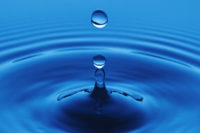Trapped in the Microscopic World of Water - Motion - Energy


Many think the science behind drying is simply drying the air; however, it is actually a complicated practice that involves advanced physics combined with applied mathematical principles. As many restorers strive to make a living, it is important to note that understanding the science behind drying wet structures is a difficult, disciplined, and often complicated process.
When flooding occurs, homeowners, building managers and insurance professionals deserve the best we have to offer. As we grow and mature as an industry, restorers have gained a substantial amount of knowledge in the field of drying. Today we are discovering new technology and better ways to utilize energy, and that’s just scratching the surface.
Restoration contractors are actually physicists in disguise, because drying wet materials involves the fundamentals of fluid dynamics and physics, due to multiple forces that entangle water within materials. That means understanding forces like gravity, friction, tortuosity, capillary action, pore size, and the laws of thermodynamics. Moisture is not excused from the laws of gravity any more than it is from the effects of heat or from cold. Water boils at 212F and freezes at 32F, at least at sea level.
Scientifically, when wet material is present during water damage and an attempt is made to salvage the material, restoration professionals employ fundamentals of mechanical physics to ensure that water moves from wet areas to drier areas. This amazing discipline must employ some form of energy. Drying is really straightforward – it consists of adding or removing heat. In other words it is all about energy.
The first law of thermodynamics states that energy cannot be created or destroyed. The second law of thermodynamics, which restorers should be familiar with states that flow of heat is from hot to cold, and never visa-versa. That is why we don’t have a “perpetual energy” machine.

Once wet material has reached equilibrium with its surrounding environment, the sum of all forces must be zero. There are many more physics and mathematical principles involved, but it all boils down to one thing – energy.
The American Society of Heating, Refrigerating and Air-Conditioning Engineers manual – “Psychrometrics Theory and Practice” – divides acceptable temperatures into three classes:
- The greatest permissible product temperature is so low that a water vapor pressure below that available with the outside air is required (e.g. dehumidification by refrigeration).
- The greatest permissible product temperature is high enough to make use of a vapor pressure sufficiently above that of the outside air but not high enough to exceed the boiling point of water as acceptable for the third class. For this class, the air is heated and new air added at a rate to maintain the necessary vapor pressure. The refrigeration method can also be used for this class of product. In most cases, refrigeration probably would increase the cost of drying, but there are cases where this is not true.
- The greatest permissible product temperature is enough above the boiling point that the pressure of the water in the product is sufficiently above the atmospheric pressure to cause vapor to flow out at the desired rate. (Not very practical for our industry.)

That leaves us with adding or removing heat, or enthalpy. Evaporation plays a major role in moisture movement, as do capillary and gravitational forces (Newton), hysteresis, permeability (Darcy), dynamic viscosity (Poiseulle), temperature, and even pore size and fiber diameter.
In my research, pore size and fiber diameter present in flooring textiles often have a tremendous impact on moisture transfer and drying time. Pore size can influence the capillary rate and controls the flow through porous materials. Fiber diameter influences the heat rate of sorption (wetting) or desorption (drying) of water by the fibers. In the drying industry, we depend on capillary action and evaporation rates but they too are influenced by gravity and wind speed. (Walk up hill - into the wind.)
With the substantial amount of knowledge in the field of science being far more than can be explained by any single scientific principle, substantial knowledge in the field will play an increasingly important role in understanding the movement of water. Why is it that water has a preferential path of movement both horizontally and vertically? Imagine walking along a level path or a steep incline or decline. Place a drop of water on level surface and it will remain there until the surface is tilted. The water will always go to the downhill side and will be wet while the uphill side will be dry. It’s simple, if we understand all of the dynamic forces at work. The science is out there – we simply need to understand it.
For years confusion has surrounded science and drying. Statements abound that our industry is as much an art as it is a science. I disagree that drying is an art – drying abides by the laws of science, just as water obeys the insatiable force of gravity. Nevertheless, we need to prove we can apply the science in a simple down to earth way that we, as restorers, can understand.
Looking for a reprint of this article?
From high-res PDFs to custom plaques, order your copy today!






